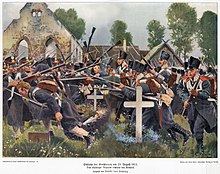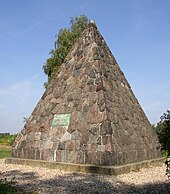Battle of Großbeeren
| date | August 23, 1813 |
|---|---|
| place | Großbeeren in Brandenburg |
| output | Prussian victory |
| Parties to the conflict | |
|---|---|
| Commander | |
| Troop strength | |
| 75,000 men | 100,000 men |
| losses | |
|
around 3,000 (including around 1,500 prisoners), 14 guns |
1,100 (dead, wounded, missing) |
Spring campaign 1813
Lüneburg - Möckern - Halle - Großgörschen - Gersdorf - Bautzen - Reichenbach - Nettelnburg - Haynau - Luckau
Autumn campaign 1813
Großbeeren - Katzbach - Dresden - Hagelberg - Kulm - Dennewitz - Göhrde - Altenburg - Wittenberg - Wartenburg - Liebertwolkwitz - Leipzig - Torgau - Hanau - Hochheim - Danzig
Winter campaign 1814
Épinal - Colombey - Brienne - La Rothière - Champaubert - Montmirail - Château-Thierry - Vauchamps - Mormant - Montereau - Bar-sur-Aube - Soissons - Craonne - Laon - Reims - Arcis-sur-Aube - Fère-Champenoise - Saint -Dizier - Claye - Villeparisis - Paris
Summer campaign of 1815
Quatre-Bras - Ligny - Waterloo - Wavre - Paris

The battle of Großbeeren took place on the afternoon of August 23, 1813 near Großbeeren in Brandenburg, today the district of Teltow-Fläming . It was part of the liberation wars . The defeat of the French prevented a renewed advance of the Napoleonic troops into Berlin and ended the French rule in the Mark .
prehistory
After the end of the Pläswitz armistice , Napoleon Bonaparte gathered the severely weakened troops in Saxony, allied with him . There the French general planned the next goal: the (re-) capture of Berlin , which he saw as a refuge of the Prussian resistance against the rule of the French. At the same time, the "Armée de Berlin" under Marshal Charles Nicolas Oudinot was supposed to establish a connection with Napoleon's north German army, which was under Davout in Hamburg .
In Luckau Napoleon's troops crossed the Prussian border. On August 21, 1813, they were about 22 kilometers south of Berlin. The armies of his opponents (the IV. Prussian army corps under Freiherr Friedrich Wilhelm von Bülow and Bogislav Graf von Tauentzien , three Russian corps under Mikhail Semjonowitsch Voronzow , Ferdinand von Wintzingerode and Alexander Iwanowitsch Tschernyschow as well as 22,000 Swedes) with a total of around 100,000 men already had about 100,000 men there Position taken: According to Napoleon's plans, they should be attacked simultaneously by Oudinot in the south and Davout in the north - but an armistice was still in force .
In the course of the following days, French troops marched ever further north towards Berlin. It came to taking Trebbin and some skirmishes in Blankenfelde and Jühnsdorf . Finally, the Prussian General von Bülow decided to occupy Großbeeren, while the French advanced further north across the marshy valley of the Nuthe .
The allies took up positions - the Prussians on the left, the Russians on the right, the Swedes in the center. At Blankenfelde there was a skirmish which was broken off by General Henri-Gatien Bertrand around 2 p.m. when the 7th Army Corps had still not appeared.
course
Around 4 p.m. the first French troops appeared in the pouring rain in front of Großbeeren. They belonged to General Reynier's 7th Army Corps. Since they found Großbeeren occupied by the Prussians, they opened artillery fire and drove the Prussians out of the village after about an hour. The Prussians took up position near Heinersdorf , about four kilometers north, the French moved into bivouacs in Großbeeren.
Since General von Bülow did not expect to have the full French troops in front of him, he decided to attack against the will of the Commander-in-Chief of the Northern Army , the Swedish Crown Prince Karl Johann . A gun line of 64 cannons opened fire, to which the French responded with 44 more powerful Saxon guns. At the same time, Prussian troops attacked from Kleinbeeren to the east of the village.
General Reynier now finally realized that the Prussians were serious. He had his left wing reinforced by six Saxon battalions from the second meeting. His Prussian adversary, however, gave the order for a bayonet attack with a total of 35,000 men at around 6 o'clock in the evening. The battalions positioned behind the guns advanced in stages into the devastated village, where they forced Napoleon's troops to retreat. The second Saxon division also gave way to the superior force.
At the same time, Marshal Oudinot, whose troops had lagged far behind Reynier's during the day, reached the nearby Ahrensdorf . He immediately sent 2,000 horsemen to support Grossbeeren, who launched a night attack, but were repulsed by the Prussians.
That same night Reynier and Oudinot decided to retreat to Wittenberg . The attack of the Napoleonic forces on Berlin had failed and the Prussian capital had been saved from being conquered by the enemy. The Girard division, which had advanced from Magdeburg , was wiped out on August 27, 1813 near Hagelberg .
Commemoration

In memory of this battle, one street in Potsdam and Bremen and two streets in Berlin bear the name Großbeerenstraße.
In the former churchyard of the Evangelical Church of Großbeeren, a cast-iron obelisk designed by Karl Friedrich Schinkel was erected on a stone plinth in 1817 to commemorate the battle . With its rich pin jewelry , it echoes the national monument for the wars of liberation on the Kreuzberg.
In Großbeeren, a memorial tower inaugurated on August 23, 1913 commemorates the battle. It bears the following inscription: “Here on August 23, 1813, the French army was defeated by the Prussian troops under General von Bülow. The victory saved Berlin from the threat of French occupation. "
Behind the battlefield, a memorial plaque on a 10 meter high pyramid made of field stones contains the words of General von Bülow: “Our bones should pale in front of Berlin, not backwards.” With this he disregarded the order of the Swedish allies to stand on the Berlin customs wall (at that time mostly "City Line" or just called "Line"), and gave the order to attack the French and their allies.
The Großbeeren Victory Festival is celebrated once a year. As part of this folk festival , the battle is re-enacted by citizens from many cities and historical associations in historical uniforms and with historical devices.
The 3rd Westphalian Infantry Regiment Freiherr von Sparr received the nickname “Hacketäuer” during the battle of Groß Beeren because the Westphalian soldiers were driven forward with the shouting “Hacke Tau” (“blow close”) after their rifles had become unusable for shooting due to rainy weather were. Numerous streets and settlements in North Rhine-Westphalia bear the name "Hacketäuer" in memory of this infantry regiment.
See also
literature
- Theodor Fontane : Walks through the Mark Brandenburg , Vol. 4: "Spreeland". In it the main part on the left of the Spree with the chapters Großbeeren and The Battle of Großbeeren . In: Complete Works , Vol. 12. Nymphenburger, Munich 1959–1975, pp. 263–271 (first edition 1882).
- Frank Bauer: Großbeeren 1813. The defense of the Prussian capital . Vowinckel, Berg am See 1996.
- Frank Bauer: Großbeeren August 23, 1813 . In: Small series history of the liberation wars 1813–1815 , issue 1, Potsdam 2003.
- Max Wald: The Battle of Großbeeren . Limestone Mountains (Mark) 1911
- Max Wald: Flämingheft 5 in 6 editions:
- 1st to 3rd edition: From the French era in the Jüterbog-Luckenwalde district . Dahme / Mark, 1926, 1928 and 1937
- 4th to 6th edition: From the French era - Großbeeren and Dennewitz . Dahme / Mark, 1940, 1942 and 1943
Individual evidence
- ↑ R. Braeuner: History of the Prussian Landwehr. Historical representation and illumination of their prehistory and later organization . Volume 1, Berlin 1863, pp. 212-220 .
- ↑ R. Braeuner: History of the Prussian Landwehr. Historical representation and illumination of their prehistory and later organization . Volume 1, Berlin 1863, pp. 211-212 .
- ↑ Großbeerenstraße (Kreuzberg). In: Street name lexicon of the Luisenstädtischer Bildungsverein (near Kaupert ) on the Generalszug and Großbeerenstraße (Lichterfelde). In: Street name lexicon of the Luisenstädtischer Bildungsverein (near Kaupert )
- ↑ Detlef Albrecht: Historical short stories from Westphalia. Of murder, witches, Feme, feuds and wars . Menden 2010, ISBN 978-3-00-029347-4 , p. 216.



